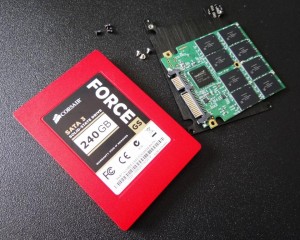 Our report today examines the newly released Corsair Force GS 240GB SSD.
Our report today examines the newly released Corsair Force GS 240GB SSD.
The Force GS enters the SSD market as Corsair’s entry model Toggle Mode NAND SSD candidate and it is one of the few to use SanDisk’s Toggle Mode NAND flash memory. By relying on Toggle Mode memory, Corsair is willing to bet that the Force GS Series will be able to provide both fast read and write high sequential performance as well as dynamite random write speed for an even better user experience.
SPECIFICATIONS
Corsair Force GS Series SSDs are available in capacities of 180, 240, 260 and 480GB; Corsair relying on the current trend of lower SSD prices luring new buyers to higher capacities. Performance varies for different sizes and our sample drive is rated at 555MB/s read and 525MB/s write with 90,000 IOPS at 4k aligned random write disk access.

 A quick check of Amazon
A quick check of Amazon![]() shows pricing at $164.99 (180GB), $217.29 (240GB), $338.17 (360GB) and $440.37 (480GB) which brings it to about $0.90/GB for the 240GB sample we are looking at today. The Force GS family includes a standard three year warranty and packaging includes a 2.5″ to 3.5″ desktop adapter.
shows pricing at $164.99 (180GB), $217.29 (240GB), $338.17 (360GB) and $440.37 (480GB) which brings it to about $0.90/GB for the 240GB sample we are looking at today. The Force GS family includes a standard three year warranty and packaging includes a 2.5″ to 3.5″ desktop adapter.
SSD COMPONENTS
 The Corsair GS 6Gbps SSD is built on an undersized PCB that contains the LSI SandForce 2281 Flash Storage Processor (FSP) and sixteen modules of SanDisk 24nm Toggle Mode NAND flash memory (SDZNPQBHER-016GT).
The Corsair GS 6Gbps SSD is built on an undersized PCB that contains the LSI SandForce 2281 Flash Storage Processor (FSP) and sixteen modules of SanDisk 24nm Toggle Mode NAND flash memory (SDZNPQBHER-016GT).
Each module is 16GB in size for a total RAW capacity of 256GB. LSI SandForce firmware needs, over provisioning and final formatting leave the end user with 224GB of available storage space.
 The SSD Review The Worlds Dedicated SSD Education and Review Resource |
The SSD Review The Worlds Dedicated SSD Education and Review Resource | 
Doesnt the Sandisk Extreme SSD 240GB use the same toggle NAND??
The identification numbers do not match that of the extreme. We have word that the answer is no but are hesitant to commit until SanDisk can confirm.
when will the days of drive makers OVERQUOTING the size of their drives, if I buy a 240GB drive, I want to use 240GB not a byte less!
Well, there is 2 answers to that question, its not only a ? about them deliberately putting incorrect values ??on, if i remember right its also the hole bits to byte or the other way around, but i got a IT education and a CCNA,but i cant remember the all the dif. values, other than a byte is “Normal” 8 bits, if u dont also count the “overhead”,then it can b 9 or even 10,hehe,anyways,the companys that sell u a HD define a megabyte = 1,000,000 bytes, but some OS/Programs/Systems(like Windows/Fdisk/Bios) say that a MB is = 1,048,576 bytes (if u dont belive me, go find a big file and right click on it, windows will say its like 6.5GB, but then in ( ) it will say its = 7.082.606.592 byte, so there u have why when they say the HD is 1TB, and u format it,and right click on it,it will never ever say u got 1 TB free! Hope u could use my answer, else try and google “what is a byte” or “Byte to bit converter” or what ever size u wanna get the “real” value of, like “TB to GB converter”!
Sincerely, Funk606
i have just put one of these drives into my dell xps 17 l702x and when i run crystaldisk im only getting about 45MB/s 4k write. should i be concerned? your help would be much appreciated
Conduct the test while your system is in safe mode and see the 4k result. It shoud be higher and this will let you know whether it is SSD/install related or he result of the OS environment. It is not Crucial that it be higher but we like to see it. Did u migrate or do a fresh install?
Thanks for quick reply. I did a fresh install of windows 7 and followed the optimization guide on here. My atto result is a tad off aswell. Only got 488MB/s write although the read hit 552. Just wondering if different systems with different hardware would affect the result
Have you followed my advise and tested in Safe Mode?
Yes I tested in safe mode with the same results. Not sure what it could be.
My sequential write on crystaldisk only hovers around the 200 mark too
I have Silicon Power V60 240GB for testing at the moment, it has the same Toggle Mode SanDisk Nand Flash modules found inside the Force GT, it is showing great performance up till the moment as well, with only 202 $ price tag @ Amazon. This is a real deal 🙂